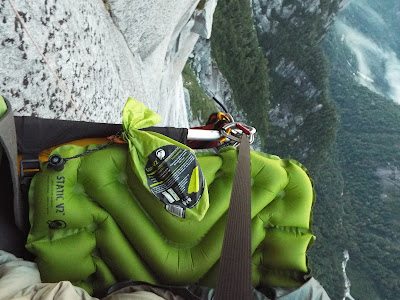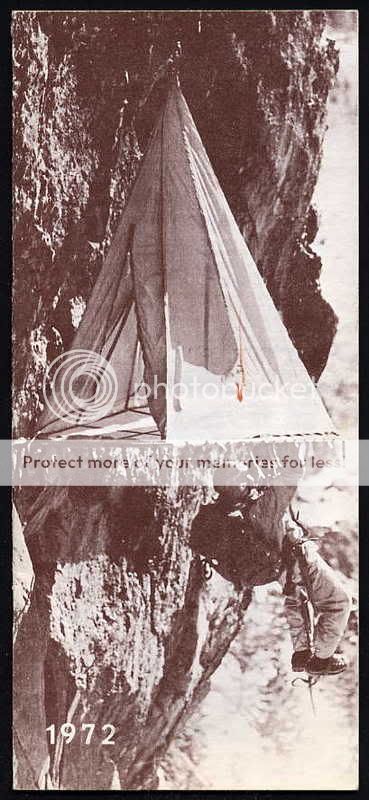 |
| The Klymit Static V2 in use 900m off the deck whilst new routing in Patagonia |
 |
| A pretty meagre bivvy on a tiny patch of grass |
In fact, a decent pad is key to getting a decent rest and keeping warm through the night. A poor sleeping bag can be easily made up for with layers of clothing, but nothing really works that well underneath you. The weight of your body will compress most insulating layers so that they no longer trap the air pockets needed to stop you losing precious body heat through the night.
On a big wall, these effects are amplified, since you will generally either be sleeping on bare rock, or snow which will both leech large amounts of body heat. In the case that you are on a Portaledge or hammock, you have moving air underneath you which can be even worse.
 |
| I took the cut down foam pad that night - no surprise I was the first one up to take this picture! |
Firstly, they are very bulky when packed. This is usually got round by doubling them up as haulbag liners, but when you do this it often means they are either too annoying to get out, or get forgotten to put back in in the morning so your haulbag has no liner and gets damaged.
Secondly, they are just not that great as insulators. Fine in a sheltered camping spot with a good sleeping bag, but up on the wall exposed to the elements and using the smallest sleeping bag you could find to save weight and space, it becomes more of a problem.
The second problem can be addressed by using a closed-cell self-inflating type camping mat, but these are both heavy and bulky so become impractical for all but out-of-the-car camping.
When I saw the new style of camping mats coming on to the market that could address both issues, I was interested to see whether they would become a viable alternative on the wall.
The light weight air bed style mats have now been around for a little while, offering a bit of choice of design, and I have tried a few from Klymit, Therm-a-rest and Alpkit.
 |
| The Klymit Static V2 - officially Portaledge friendly! |
On first impressions, the Static V2 is a very different design to that of the competition. What they have done is to inflate alternate cells instead of every one, meaning that you have small gaps inbetween. This designs allows a few important things. Firstly it just enables you to blow it up a lot quicker as it needs a lot less air. Secondly, it means they could make it really quite thick so it is more comfortable, and third it allows it to bend to contours more, meaning it fits better into hammocks and saggy portaledge beds.
They have also been quite clever with the sizing of the cells. The outer cells down the sides and at the head end are slightly larger, meaning you are less likely to roll off in the night, and can even get away without a pillow if needed.
On closer inspection, Klymit have used a burlier fabric than that of the other ones I have seen. While this may add a couple of grams, it is reassuring to know it will last longer. It also means it doesn't have the annoying crinkly plastic bag noise that I found with the Thermarest NeoAir.
 |
| The included repair kit tucks away in in its own neat little pocket and includes a generous size patch for top and bottom and plenty of high quality glue |
A side note on the repair kit - we actually got a lot more use out of it when the sole came away from my approach shoe. The glue they included was just enough to keep my shoe intact for a load more aid climbing and the hike out, so it really did save the day!
 |
| Our first night out on the new portaledge - comfy and warm all night |
Using the mat on the portaledge was great. It was so quick to get out and pack away that it was never a chore, and I was easily able to fix a small cord to the valve so that it could be clipped to the ledge while inflated. It fit exactly into the space on my ledge, which is a fairly compact one (RunOut Customs UL Double) so it should be fine on any other. I was using a very light sleeping bag for two weeks of portaledge sleeping and only got cold on the one night I didn't use the mat.
 |
| Tucked in nicely in a small size hammock |
Using these mats added a few grams of extra weight compared to standard foam mats, but actually saved us a lot of space in the haul bag. It also meant we were able to leave a cut-to-size foam mat in the haulbag to protect it, and therefore knew we had an emergency spare if one was dropped (always a possibility!)
While on expedition in Patagonia, me and the rest of the team spent somewhere around 75 nights each sleeping on the Static V2 mats either in camp or on the wall. We all loved them, and have been recommending them to everyone we know since.
 |
| The stunning Cochamó valley from the comfort of the ledge |
 |
| The same ledge seen from above |
There are two very small complaints I had with it, though these are both common to all mats in its class. One is that the bottom is a little slippy, I would like to see a something to just add a little friction underneath. The other is that although a cord around the valve works for a keeper string, I would prefer to see a dedicated clip in point. These are both trivial complaints though, in everything important this mat is excellent.
A great mat, well worth the money and significantly better than the competition. Highly recommended!
 |
| 5 out 5 Pitons |
Tech Specs from Klymit
Price $64.95
Weight 16.33 oz / 463 g
Dimensions 72" x 23" x 2.5" / 183 cm x 59 cm x 6.5 cm
R-Value 1.3
Inflation 10-15 Breaths
Pack Size 3" x 8" / 7.62 cm x 20.3 cm
Fabric 30D Polyester Top, 75D Polyester Bottom
Warranty Limited Lifetime





















